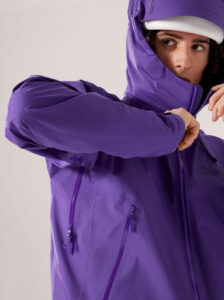
Image courtesy of Arc'teryx
Arc’teryx has made a big leap forward in its best-selling Beta and Beta Lightweight jackets, making them with GORE-TEX ePE membrane, a material which keeps you dry without the use of PFAS.
Though PFAS (Per- and Polyfluorinated Substances) have been used in consumer clothing around the world for years, they have also been linked to a wide range of health risks. Arc’teryx’s latest steps are an effort to reduce the company’s footprint and improve its sustainability — and, ultimately, to eliminate the use of PFAS altogether.
While some sustainability changes can come at the cost of performance, Arc’teryx said the result of using and ePE membrane has been a more efficient shell jacket for mountain athletes that is lighter, more durable, as waterproof and as breathable as the previous iterations.
Removing PFAS from these redesigned Beta models was not a simple case of swapping one membrane for another; it required a total redesign. The Arc’teryx design team spent over two years re-engineering the jackets, testing and re-testing their performance with new membranes, face fabrics, backer materials, seam tape and DWR coatings.

Image courtesy of Arc’teryx
The company worked closely with GORE-TEX to develop the PFAS-free ePE membrane, testing and co-creating to ensure it met the brand’s exact performance standards. The new GORE-TEX ePE membrane technology is lighter and thinner, allowing for higher denier.
Arc’teryx also worked to create its own recycled and dope-dyed face fabrics, and more sustainable backer fabrics.
So what are the hard numbers in terms of the sustainability changes. According to Arc’teryx, using data calculated through the HIGG MSI index, the new Beta Jacket reduces the carbon impact (in CO2e) by 12 percent compared with the fabric used in the past. Arc’teryx also calculated a 34 percent reduction in carbon impact with the Beta Lightweight Jacket, compared to the fabric used in the past. They have not yet been third-party verified.
 Your Privacy Choices
Your Privacy Choices
 The
The